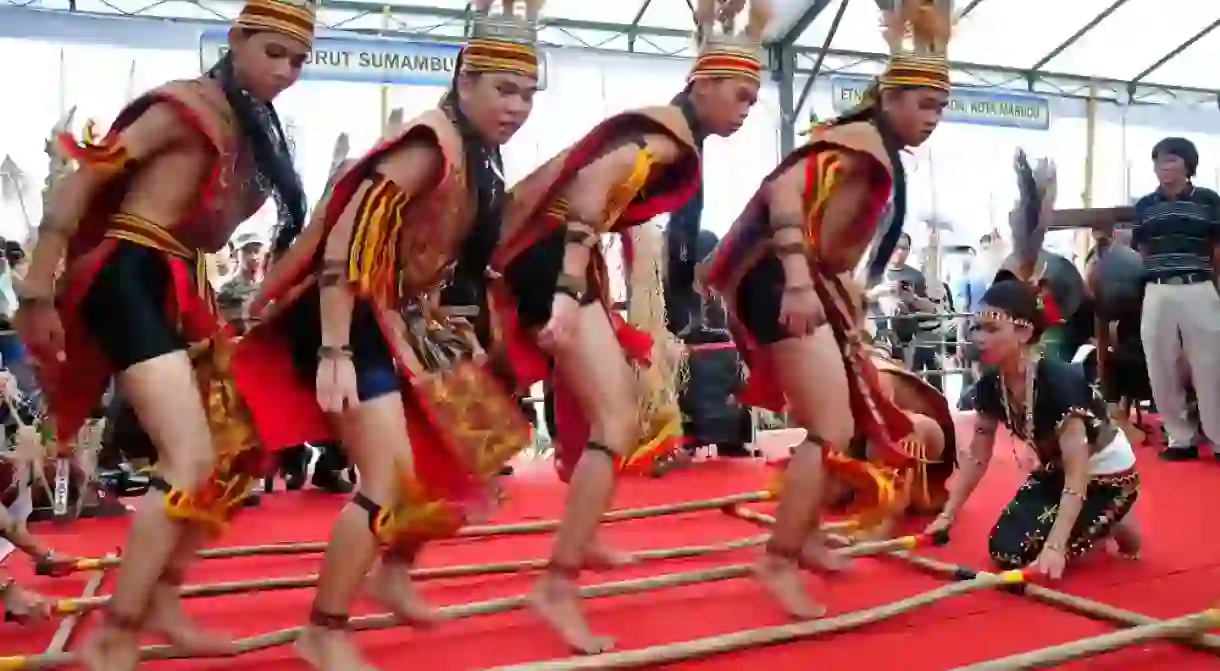Magunatip: Sabah’s 'Floating' Bamboo Dance

Sabah’s most famous traditional dance, the Magunatip, combines skill, precision and agility. Dancers hop in and out of two clapping bamboo poles where the slightest miscalculation could lead to a trip to hospital. But this jaw-dropping spectacle performed by the Murut tribe has roots in paganism, healing ceremonies and headhunting.
The bamboo dance
Two dancers sit opposite each other holding two pieces of bamboo. Slowly they start to tap the poles together on the floor, creating a rhythm. Add in the sounds of gongs and the Magunatip dance is ready to start. Two Murut dancers donned in traditional clothing and headdresses jump in between the clapping bamboo. Crowds marvel at their dexterity as the dancers move in perfect sync and avoid hitting the bamboo. Slowly the tempo increases. The clapping gets faster. From a distance, the dancers almost appear as if they’re floating with the mind-blowing speed of their movements. Suddenly, the excitement ends without injury to a cheering crowd. This is the Murut Magunatip dance. Once performed for returning headhunters. It’s now a familiar dance at cultural events and festivals throughout Sabah.

A farmer’s joke becomes a folk game
According to Murut village elders, a mischievous farmer started the tradition generations ago. The prankster modified two bamboo poles into a contraption to trip his friends up during breaks. As the bamboo clapped together, people would jump and hop to avoid the painful smack on their ankles. People began to see the funny side, which gave birth to a soon-to-be folk game. This evolved into the bamboo dance. Later it transformed from a bit of fun in the fields to holding crucial roles in pagan rituals and headhunting celebrations.

Healing rituals
Sabah’s indigenous people were deeply animistic. The clapping of the bamboo combined with the gongs, they believed, kept evil spirits away. And without these malicious entities, the village would prosper. The early version of the Magunatip quickly became part of the Angkalatung healing ceremony. Murut communities believe the noise and ritualistic movement of the feet warded off the spirits that made people sick.
Warrior dances
At around the same time, Sabah’s Murut tribes were at the height of their fearsome headhunting campaigns. The warriors needed to demonstrate their manhood. All men had to capture a head before they could marry. Headhunts were a standard part of village life. As the warriors returned, the villagers performed the Magunatip to welcome the victorious warriors. The sounds of clapping, gongs and cheering made the blood of villagers in nearby areas run cold.
Today’s Magunatip
The modern-day bamboo dance mostly takes place at ceremonies and cultural shows. Rural communities still dance the Magunatip at special events, including engagement ceremonies and weddings. It’s a common sight during Sabah’s Harvest Festival and at some of the classier restaurants too. Bamboo dances are no longer associated with pagan spirits and warriors. Instead, they combine a glimpse into ancient pagan rites and a spectacular performance found nowhere else in Malaysia.














